#Muscadine Grape Plant
Explore tagged Tumblr posts
Text
fighting for my LIFE against the muscadines again boys
#lindsey shut up#unwinding tendrils from the poor blueberry bushes mumbling ‘spit it out. SPIT IT OUT.’#listen I love having native plants. im proud to have the muscadines and im glad they are flourishing.#but CAN YOU FLOURISH A LITTLE LESS#european style grape vines: is this rainwater? im allergic#muscadines (bred by indigenous nations over centuries): hi I noticed a square inch of bare salted dirt no one’s using. mind if I slide in#the thrashers have a nest in the thicket that they’ve used to raise chicks two years in a row#the pollinators are going apeshit for the blackberry flowers#me? just trying to separate the shrubs like fighting kids like LET GO OF THE TULIP TREE. LET GO RIGHT NOW#bane of my life these fucking muscadines. you couldn’t pay me to remove them tho
12 notes
·
View notes
Text
Cultivate a Taste of the South with Muscadine Grapes: A Flavorful and Resilient Addition to Your Garden
When you want to add something unique to your landscape, think Muscadine Grape. These very different fruits grow in southern regions and are known for their strong, sweet taste. Muscadines, which range from dark purple to green, not only look attractive on the bush but also grow grapes that make everything from fresh meals to homemade wines. Their hardness requires little maintenance, making them excellent for both new and experienced gardeners. Also, the great quantities of vitamins and minerals in these grapes provide amazing health benefits. Growing Muscadine grapes is an enjoyable pastime that connects you to the environment while also gratifying your palate, resulting in memories and exquisite dishes for years to come.

2 notes
·
View notes
Text

Hey #Lovers❤️🔥! Experience the magic of muscadine grapes 🍇 on 🌺RAW1111.COM🥑. Discover why these Southern “bullets” 🎯 are a must-try! #GVWU Go Vegan With Us 🌱💚
#muscadines#bullet#grapes#native#native americans#native american#native plants#native flowers#north america#native tribes#cherokee#creek#spanish#south#ancient history#history#educate yourself#education#vegan#raw vegan#nature#vegan food#fruits#vegetables#vegan lifestyle#realnessalwayswins#gvwu#plantbased
2 notes
·
View notes
Text
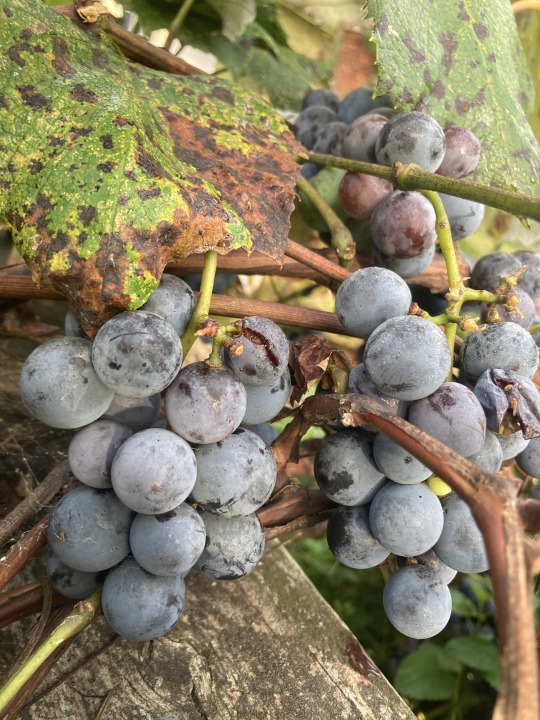
Muscadine grape (Vitis rotundifolia). "Season of mists and mellow fruitfulness..."
#muscadine wine is popular around here#its very sweet and to my taste very gross#grapes#native plants#nature#nature photography#autumn#september
4 notes
·
View notes
Text
My first Nopales (Cactus Paddle) Forage

Opuntia humifusa, commonly known as the devil's-tongue,eastern prickly pear or Indian fig—in my neck of the woods we go with prickly pear.
It grows in the eastern US and north eastern Mexico where it is a well known ingredient in many dishes. You can buy it here at the Mexican markets as a fresh paddle with the spines removed or at the grocery store pickled.
I’ve grown up with it all over the woods on both my parents property and the acreage were are currently living on. The little patch I harvested from today is growing in the middle of the muscadine vines that I photographed with teeny tiny grapes earlier this week.
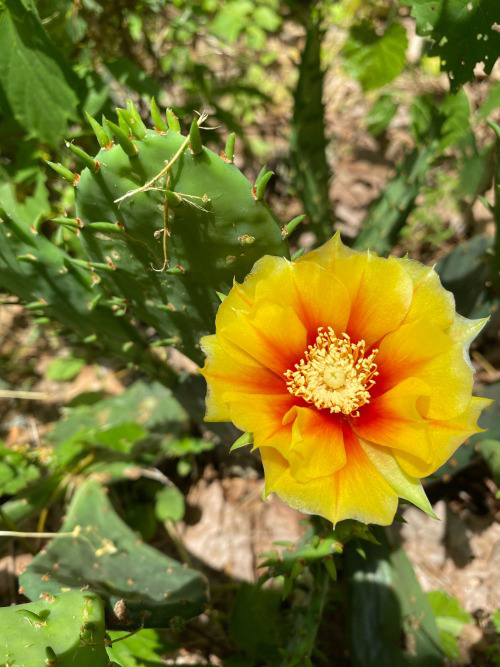

I haven’t seen any flowers yet this year, but it should be soon as the above photos were taken on May 31 and June 1 (on the Kupala altar) in 2023.


To harvest I brought a plastic bowl (I didn’t want spines in my foraging baskets), gloves, tongs, and a knife. Using the tongs to hold on to the new, tender, light green pad, I used the knife to slice it where it connected to the rest of the plant.
The young paddles are tender and have less spines.


When I got back to the kitchen I sliced the very bottom off of the paddle and sliced around the edges. Then using the knife I scraped the top and bottom to remove any spines. Working by myself I couldn’t really get photos or video so I’ve linked to one from YouTube below.

You will notice as you prepare the paddles that they are mucilagenous like aloe vera. In fact, when I did some research into medicinal uses of the plant the article I was reading mentioned Native American use to heal wounds and burns.
To store the paddles line a container with paper towels for up to a week. I also read that they can be frozen raw for up to 6 months. They can also be pickled.
For my first dish with foraged nopales I made nopal quesadillas
youtube
@sagescented @heatherluvsart
#nopales#cactus paddles#prickly pear#foraging#ozark foothills#food#cooking#mexican food#Mexican cooking#Kupala#summer#late spring
19 notes
·
View notes
Text

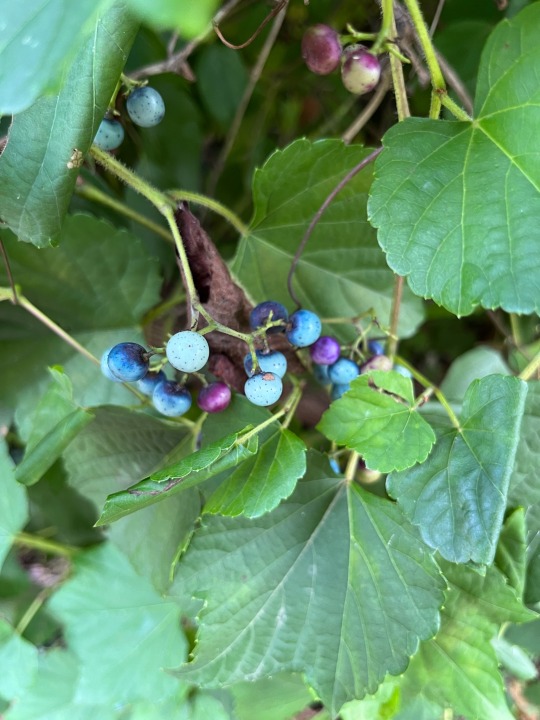
The plants look like wild muscadine grapes but these are actually called porcelain berries
#my photography#original photography#nature photography#porcelain berries#naturecore#cottagecore#adventurecore#gremlincore#forestcore#plantcore
11 notes
·
View notes
Text
Potted Plants And More
Pomegranate flowers everywhere! It’s rainy out though. Hopefully these don’t get heart rot. Netted mulberry. Marionberries in a pot. I moved these out of a raised bed. They go nuts down here. I’m sure if I let it, all I would have is this plant! Variegated weigela. It’s done flowering and will start looking ratty in our heat. Muscadine grape. I have an older one in the ground. If you see…
0 notes
Text
Potted Plants And More
Pomegranate flowers everywhere! It’s rainy out though. Hopefully these don’t get heart rot. Netted mulberry. Marionberries in a pot. I moved these out of a raised bed. They go nuts down here. I’m sure if I let it, all I would have is this plant! Variegated weigela. It’s done flowering and will start looking ratty in our heat. Muscadine grape. I have an older one in the ground. If you see…
0 notes
Text
Mighty Fine Wine
It has been fun watching my daughters grow up and develop their tastes and preferences, from individual brands to specific product categories. Being young, they are having to try a lot of things to expand their knowledge and understanding. They are limited by their pocketbooks. And, in some cases, their predilections are rather basic, not yet refined.
Like with wine. As I watch them peruse the thousands of bottles on display, be it at Walmart or Total Wine, they gravitate toward less expensive bottles, as you might expect, but also toward sweeter wines. I am thinking of Stella Rosa black specifically. It sounds sophisticated, but it is just a modern version of the Boone’s Farm we drank decades ago as kids, or what is known pejoratively as Three Buck Chuck (from Charles Shaw) at Trader Joe’s. Inflation has pushed it to Five Buck Chuck nowadays, though.
It’s a cheap buzz, and if you hide the bottle, you might just impress your guests.
The only problem, though, is that wine consumption continues to drop, and concurrent with that, so is production. In fact, global wine production has now dipped to 1961 levels. That’s huge, because world population was only three billion then, and stands at eight billion now. Basically, we’re just not drinking wine like we used to, not even close.
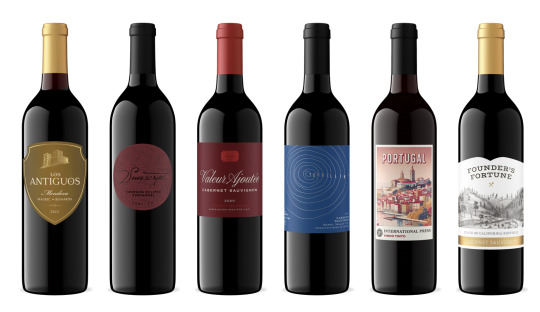
Much the same can be said of beer. Both wine and beer were daily go-tos, replaced today by a slew of non-alcoholic options, not to mention seltzers. Wine is being consumed more as a special occasion beverage. A large portion of this tidal shift is coming from younger consumers, who are drinking much less than their parents and grandparents did, and sometimes even none. In other cases, though, when they do drink, they are reaching for more expensive varietals, as well as organic and orange wines.
That’s got to be tough news for wine producing regions of the US, from Napa Valley to Texas Hill Country and north Georgia. Wait. Did he just say Georgia? Oh, yes. They turn those muscadine grapes into bottled goodness. They have to be getting nervous, though, hoping that younger customers will choose their more expensive bottles a little more frequently than they are today.
Still, I have to think that it is even worse news for the cheaper wines, the Stella Rosas and 19 Crimes that you can pick up for $10-12 a bottle at the grocery. Those bottles are starting to gather dust.
Actually, I see a lot of opportunity for those craft wineries. As a much older adult, I love doing wine tours. My wife and I will go winery hopping in Texas Hill Country around Fredericksburg, or in north Georgia. Nothing beats sitting under a tree in a huge Adirondack chair, sipping a $15 glass of wine, looking out over rolling hills planted with demonstration crops of grape vines. It is the perfect tableau, one that endows relaxation, but also lubricates the wallet. Those vines you see there are for looks mostly, because the grapes they produce cannot come close to being sufficient for producing many cases of wine.
Truth be known, those wineries in Hill Country get the vast majority of their grapes from the Lubbock area, and over in north Georgia, if you don’t like the sweeter taste of a muscadine wine, they can offer you dry Cabs and Pinots made from grapes they have shipped in from California, Oregon, and Texas. Turns out only muscadines will grow in their acidic soil.
All of this reflects changing consumer preferences, and specifically among a younger demographic. How the industry adapts to these changes is critical for its long-term success. The nearly 100 wineries within an hour of Fredericksburg are completely dependent upon people regularly drinking wine, and lots of it. More so, since most of these small wineries do not have distribution in stores but instead are only available at the winery, this is exceedingly important.
I need to do a better job of educating my daughters on fine wines, helping their tastes mature as their discretionary incomes increase. But if they do like their contemporaries, they may opt for less and less of anything alcoholic. And, I must also be cognizant of gender differences in taste preferences, with women—and I say this carefully, because I know my step-daughter and sister-in-law defy this—opting for sweeter wines, and men for dry ones.
As for me, I have witnessed my own wine consumption slow down a bit. Not that it was ever out of control, mind you, but I noticed my wine rack, that was once filled to capacity with 12 bottles, now has five. And it has been a while since I had any at all, at least a month, like before my surgery.
In order to capture the attention of that younger demo, the entire industry needs to lean heavily into digital, and specifically social media. Old people like me may make for great wine tourists, but our days are numbered, and given the sad reality that age and the number of meds you are on are highly correlated, alcohol consumption must be in measured doses. That’s another way of saying, once more, that old people cannot be counted upon to lead companies and industries into the future. That’s the job of the young.
And I will drink to that.
Dr “Make Mine A Tempranillo” Gerlich
Audio Blog
0 notes
Text
Literally hell except for kayaking through the marshes watching the red-winged blackbirds weave around each other in a dance. Seeing rainbows on the swamp water. Observing cypress knees like they are fairy cities. Glimpsing a bob cat, hearing deer bound off in the distance, watching an alligator sun itself or an otter slink away. Picking muscadine grapes in September, looking for the best blackberries in April with your friends by the football field, climbing a mulberry tree, stumbling upon a blueberry bush in summertime. And walking along Angel Oak's limbs, covered in resurrection fern, Spanish moss, seeing your first painted bunting through the trees and then when spring comes around jumping over to West Ashley visiting plantation gardens to see all the camellias and azaleas blooming. Smelling the wisteria in the air, sucking nectar out of Japanese honeysuckle, stuffing your face into magnolia blossoms, or confederate jasmine, or Lady Banks rose to get that sweet smell one last time this year. And walking through the neighborhoods on the southern part of the peninsula, peaking into peoples' back gardens because they're out of town anyway, smelling the horse manure and smoked meat Downtown while looking at all the flower boxes, hearing distant clopping of hooves on cobblestone streets. Popping into the Gibbes Museum, looking for Lavinia Fisher through the windows of the old jail. Finding your first hidden Andre the Giant. And then going to the aquarium for free because dad works for the county parks. Sitting in line for the Festival of Lights watching the same display repeat itself for thirty minutes. The world being empty when it snows. "Oh so that's where they filmed it." Religiously watching The Notebook, Forrest Gump, Rich in Love, The Great Santini, The Big Chill, devouring Pat Conroy and any book on ghosts you can find. Being surrounded and reminded of history constantly. Growing up next to unmarked, slave graveyards and finding green glass, buttons and white clay pipes after rain. Gullah Geechee culture. Hearing it spoken when you least expect it. Haint blue on windows and doors. Bottle trees. Putting a broom by the door for a Boo hag. Being ridden. Not being able to sleep as a kid after being told the story of the Plat-eye. Then swearing to never take the shortcut through the woods. Watching people weave pine or palmetto or sweetgrass baskets. Palmetto roses sold outside the grocery store. Ironwork. Cast iron plants under live oaks. Passionflower. Getting lucky one year seeing lotuses on the water. Rice gates. The spring peeper symphony driving along the woods in the morning. Cicadas in the summertime. Looking above at loblolly pines worried they're about to fall over in the wind. Fighting crawfish. Catching a glass lizard. Feeling fish swim by. Friends got a boat. An uncle flying over waves on rough sea. Only the mast of a sailboat seen as it slowly passes through a drawbridge. The puttering of a Jon boat nearby. Bridges a mile or two long stretching over the width of a river and surrounding marsh. Being surprised by a pod of dolphins in brackish water. Drawing graffiti on Folly Beach's left side, watching the surfers stand around. Finding a way to pass by people fishing on the beach without messing with their line. Pelicans in a row. Seeing a pink ibis within a huddle of white ibis. Waking up early for a sea turtle hatching. Baby flippers peeling over your foot. Shrimp boats on the horizon. The smells of the fish market. Shucking oysters. Fish fry at sunset. Getting through what's left to fry cause it's 9pm. Shrimp and grits, fried green tomatoes, red rice, collards, pimento cheese. Tomato sandwiches, cucumber sandwiches. Fried catfish for breakfast. Key lime pie from King's Market. Peaches sold by the basket in Lexington. Passing a pecan orchard. Boiled peanuts poolside. 20 years behind. But yeah besides that it's basically one of the all time worst places to live.
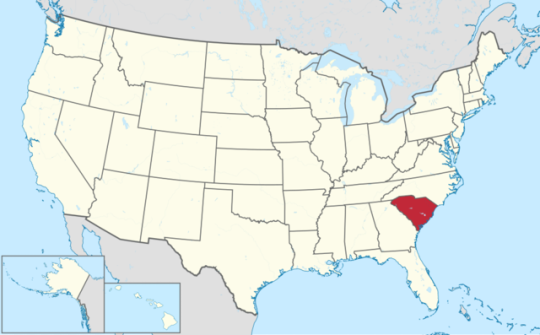
57 notes
·
View notes
Text
Muscadine Grape Varieties: Find the Best Type for Your Garden
Look at several Muscadine grape varietals, such as the popular "Scuppernong" and "Noble" varieties. Choose the variety that best suits your climate and tastes to savor this robust and tasty fruit.

#muscadine grape#buy muscadine grape#plants for sale#online nursery#online plant nursery#garden plants
1 note
·
View note
Text
Produce I want to grow in my garden bc i want to stock my own fridge/freezers:
- peaches
- pecans?
- lemons
- apples
- oranges? (Idk how theyll fare in GA winters lol)
- snap peas
- okra?
- rice? (Very small, for little 'symbolic' meals)
- squash
- zuchinni
- tomatoes
- strawberries
- blueberries?
- cucumbers
- eggplants
- hot peppers?
- muscadine grapes? (These are good but many growers sell or give them away here)
- onions
- Ube
- sweet poato
- cabbage
- spinach
- plums?
- various herbs (I'm not very picky! Maybe basil and oregano)
- sunflowers? (Idk abt this one! I have the seeds tho)
- peppers? (This will prolly be grown for others lol i dont like peppers very much)
Where am i gonna plant all these bad botanites in a 0.3 acre lot? Girl...... idk
Am i gonna have the will and energy to take care of whats basically a tiny farm? I hope so! :-)
0 notes
Text
Weather Proofing the Garden
Grape vines supported by a garden arch creating a tropical microclimate.The more delicate the plants the closer to the base of the larger trees or vines. The shade from the trees protects the potted plants and lawn from the sun during the hottest times of the day. The more delicate the plants the closer to the base of the larger trees or vines. Muscadine grape vines produce a dense canopy that…
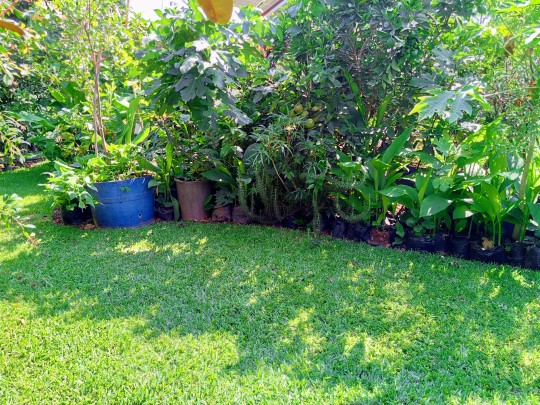
View On WordPress
0 notes
Text
I've been MIA for a few weeks. Between my mental health, starting a couple of new projects, work, and renovations, my spoons have been dangerously low.
Mental Health
I had a Myriad genetic test to see why I failed so many SSRI/SNRIs. The answer is because of the answer is because of all of the ones on the market three (3) work with my genetics. The rest are 'might be okay' or 'absolutely the fuck not.' I've already failed one of the 3, so that makes two left. It is also why I have failed tricyclics. The vast majority of them are in the 'lolnope' category. So is my current antipsychotic, so I guess I get to detox from it. >:-[
Anyway, so Pristiq is making me vaguely paranoid (vaguely being above baseline...) and now I'm sleeping around 4 hours, which is why I'm up at 0130 typing this. I'm tired all the time, have a headache, have all but stopped eating, and in general don't constantly want to unalive myself, but holy fucking fuck! I'm so tired I could drop into a coma at any point during my day. All of these are known side effects., so yay. I titrated up on my dose a week ago and all of those things have gotten worse. Also, yay.
Oh! And a couple of weeks ago I had this random asshole get angry at me on the road because I had the audacity to be in front of him and slow down to turn into my driveway. He was going to turn into the drive behind me and make the biggest mistake of his life until he saw my partner come out of the house and then he thought better of it. That's twice now in the space of a year that men have thought they were going to intimidate me by following me because I had the audacity to be afab existing alone in a vehicle. (The other got mad because I had the audacity to pass him because he was going 20mph under the speed limit.) Some of us have no flight response. That's bad for someone just wanting to be a scary jerk.
New Projects
I'm about 4k words into 2 new stories with about 8k words to edit in my finished works. The aforementioned exhaustion has got those things moving slower than I'd like, despite all of the extra hours in my day.
Work
I'm working long hours again, this last week it was 49. The two weeks before it averaged 44 each. The extra pay helps with bills since my partner was unemployed for 2 months and has worked at his new job for 2 weeks. His unemployment still hasn't come through. (Thanks 'small government' Republicans! It's great that you're in my uterus, but also want to destroy any social safety net us poors might need, you know, like unemployment. You're awesome!)
Renovations
They all but stopped until the last 2 weeks. I think daddy was sick of my partner being under foot for everything instead of worrying about getting a job. Honestly, I was, too. We moved a year ago and he's been unemployed almost half that time. If we hadn't been living in an RV this whole time, we'd have been homeless. (Not really, but mom and dad would have been paying rent or bills or something because I couldn't.) It was only when I told him that he needed to think about moving back to Missouri did he find a job and quickly. It wasn't like this before we moved. He was always employed. I also have fruits and veggies going nuts. I have a sweet potato that I'm going to put in a hanging basket. I have 6 volunteer tomato plants, two of which are losing their minds. I have no less than 3, probably, cantaloupe plants in my burgeoning compost pile. Horsenettle all over the yard, muscadine vines (wild grapes), wild petunias. This wee witch's cottage loves us as much as we love it.
The Cats
And because I need to end on a high note, I need to talk about my cats. My almost 9-year-old beastie, Clarise the former completely indoor City Kitty, has embraced the idea of being a Country Cat. She's being supervised as she explores the yard and all that our wee acre has to offer her, which is mostly grass. She has flea and tick medicine on for the first time in her life. I also discovered that her soft double coat is too dense for a tick to get through. How? I found one on her face trying its damndest to get through to her skin. It was failing. So, now we do tick checks, despite the medicine. Lt. Dan is turning into the most rambunctious little bugger as she heads toward 6 months old. Still, nothing seems to phase her, so I hope she's going to be super chill. She was desexed recently and completely unbothered by the surgery. She also got her first dose of flea medicine because she didn't weigh enough to have any yet. She is also excited to be a Country Cat, except they don't make a harness small enough for her. Fun fact: Tiny dog harnesses are the same size as kitten harnesses.

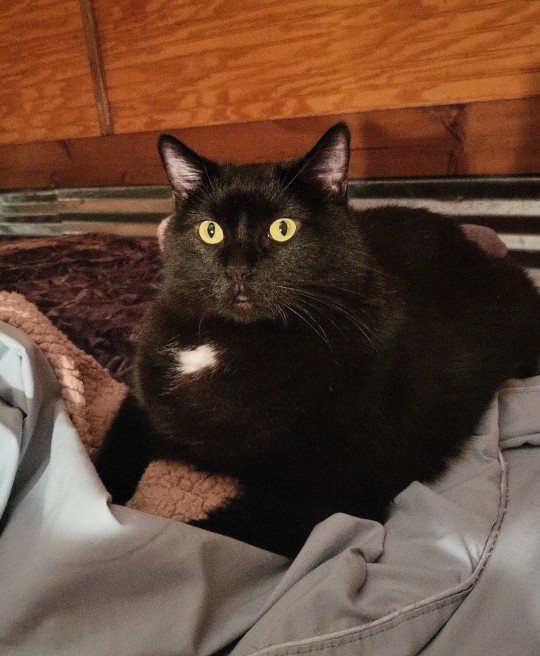


#mental health#healthcare#life#cats#mental illness#mental problems#ssri#antidepressants#side effects#writing#ao3#ao3 writer#ao3 author#tired#plants are friends
0 notes
Text
@headspace-hotel op i love you for your words but i can n o t believe you mentioned our native grapes of scuppernongs but not muscadines! scuppernongs are a tasty variety of muscadines but there are other kinds! so following this post if anyone goes out to try your local grapes and don’t love the variety you find, there are likely other varieties nearby! to my memory scuppernongs are more greenish while other varieties can be more like your typical red/purple grape? personally i enjoy the purply ones best but the green boys are also good
there’s also dewberries all through the south! most people think they’re blackberries or raspberries, not understanding the substantial size difference. if you have a local vine with small, ripe, purply-black berries, about 1/3 the size of a blackberry, it’s probably dewberries!
there’s also evidence native americans cultivated food forests that op alluded to, entire swaths of forest with specific plants intentionally placed for foraging later, plants that worked alongside each other to prosper. the old growth forests chopped down to make space for farm land were so much more than wasted timber- they were an infinite food hack that just got destroyed.
also like my knowledge is limited to my environment, but if i went outside right now i could snatch clovers, dandelions, and pine bark and have breakfast after some careful cooking. the landscape is food. lawns destroy the tons and tons of food the earth is trying to return to us, even after all the destruction that’s happened. let the clovers grow, let that weird vine take over the fence, see what blooms! i’ve been awake too long and had a long work day and op i’m sorry you’re tagged in all this but, tl;dr, destroy lawns as a concept, figure out what’s edible in your local region, and destroy the classist food system we currently have <3
(but also when “foraging” make sure you leave enough of the plants that they can come back, that’s very very important, i used to live off the snacks i found in the woods (not like as a choice but as a rural poor kid) and it matters to preserve the plant)
i promise im going to stop posting about it soon but the most insane thing about the Banana Discourse is that like. there are already lots of fruits that are of limited availability in the USA because they're not grown there and they haven't enforced massive export economies for them at gunpoint. you'd think by the way these people talk that usamericans are rioting in the streets and committing mass suicide because they can't buy a papaya or a durian or a dragonfruit at the gas station. like there's already fruits that are comparatively scarce in the USA and everyone seems to have survived that being the case but you point out that socialist revolution would require a scale back from Total Banana Ubiquity and people legitimately act like it's white genocide
4K notes
·
View notes
Text
Muscadine Grape – The Southern Delight for Home Gardens
Experience the powerful taste and health benefits associated with Muscadine grapes! These warm-weather-loving grapes are wonderful for Southern gardens and produce a delightfully sweet crop that may be used for winemaking, fresh food, and other purposes.
0 notes